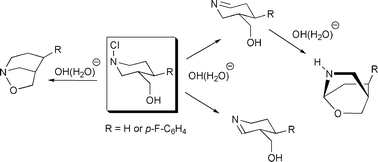Base-catalyzed reactions of environmentally relevant N-chloro-piperidines. A quantum-chemical study†
Abstract
Electronic structure methods have been applied to calculate the gas and aqueous phase reaction energies for base-induced rearrangements of

* Corresponding authors
a
Faculty of Pharmacy and Biochemistry, University of Zagreb, A. Kovacica 1, Zagreb, Croatia
E-mail:
valerije@pharma.hr
Fax: +385-1-4856201
Tel: +385-1-6394441
b
Department of Chemistry and Biochemistry, LMU München, Butenandstr. 13, München, Germany
E-mail:
zipse@cup.uni-muenchen.de
Electronic structure methods have been applied to calculate the gas and aqueous phase reaction energies for base-induced rearrangements of

 Please wait while we load your content...
Something went wrong. Try again?
Please wait while we load your content...
Something went wrong. Try again?
D. Šakić, H. Zipse and V. Vrček, Org. Biomol. Chem., 2011, 9, 4336 DOI: 10.1039/C1OB05077J
To request permission to reproduce material from this article, please go to the Copyright Clearance Center request page.
If you are an author contributing to an RSC publication, you do not need to request permission provided correct acknowledgement is given.
If you are the author of this article, you do not need to request permission to reproduce figures and diagrams provided correct acknowledgement is given. If you want to reproduce the whole article in a third-party publication (excluding your thesis/dissertation for which permission is not required) please go to the Copyright Clearance Center request page.
Read more about how to correctly acknowledge RSC content.
 Fetching data from CrossRef.
Fetching data from CrossRef.
This may take some time to load.
Loading related content
